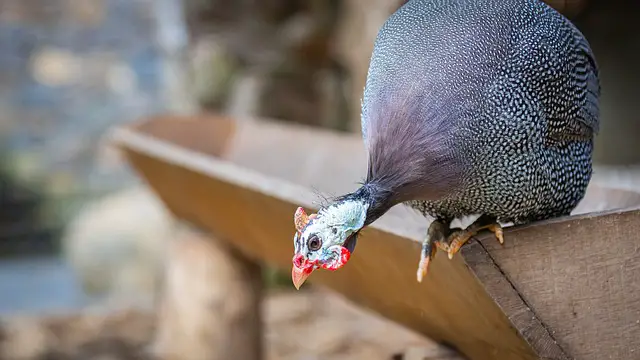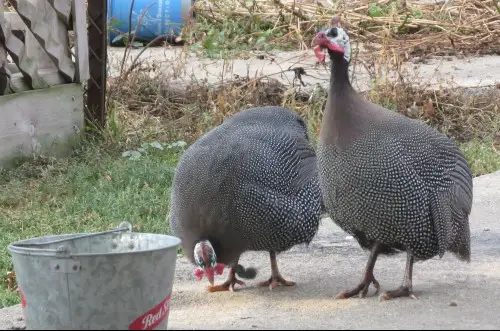Lively, noisy guinea fowl offer many benefits on homesteads, small farms, and even suburban lots. However, many wonder do guinea fowl need a coop? They have a more independent, free-roaming nature compared to chickens.
Let’s dive into the unique housing, training, and roosting needs of guinea keets and adult guinea fowl. This includes ideal coop design features, training methods for night roosting, ways to allow natural behaviors, what to avoid, and optimizing their housing for success. Get ready to discover the best practices for these quirky game birds!

Do Guinea Fowl Need a Coop?
Unlike chickens which return to the coop naturally at dusk, guinea fowl do not have the same strong instincts to secure themselves safely each night. This means they do require some housing provisions tailored to their needs.
Reasons guinea fowl need a dedicated coop or shelter include:
- Protection from predators – Housing with locks keeps guineas safe from foxes, coyotes, raccoons and dogs overnight when most vulnerable. Guinea fowl lack the wariness of chickens.
- Shelter from weather – Guineas dislike cold rain, wet snow, or chill winds. A coop shields them from harsh elements.
- Place for egg laying – Hen guinea fowl need safe nest boxes to encourage egg production. Many drop eggs randomly without nest sites.
- Feed and water access – Coops allow you to provide essential daily resources conveniently in one spot.
- Containment – Coops prevent roaming into unsafe areas or neighbor conflicts in open range situations.
- Health management – Catching guineas for care is easier when they reliably return to the coop.
Guinea housing need not be elaborate – even a simple shelter will suffice if designed well. Next, let’s look at ideal coop features to best suit their needs.
Ideal Guinea Fowl Coop Features
Guinea fowl coops should offer:
- Plenty of interior space – Minimum 10 square feet per bird. Unlike chickens, they dislike crowding intensely.
- Good ventilation – Open walls, windows, and eave gaps provide airflow. Guineas are heat sensitive.
- Roosting bars – Flat 1-2 inch wide bars raised 1-3 feet off floor allow natural perching behavior.
- Shade and sun access – Part of run should have shade options while a portion remains sunny for dust bathing.
- Partial roof and wind block – While open-air housing suits guineas, a roof and wind barrier increase comfort.
- Rodent-proof feed storage – Store feed in galvanized metal bins to prevent rodent infestation which attracts predators.
- Durable fixtures – Guineas peck, scratch and chew everything relentlessly. Use hardy construction.
- Insect and mite control – Use wire mesh, gravel flooring, and preventative dusts to limit pests attracted by their messier habits.
- Nest boxes – Provide one 12×12 inch next box per every 2-3 hens to contain the scattered eggs.
Understanding natural guinea behavior allows designing facilities to suit their needs. Next, let’s look at training methods to get them using their coop reliably.

Training Guinea Fowl to Use the Coop
Guinea keets and juveniles under 17 weeks are easiest to train for coop use. After that point, their independent nature strengthens. Here are tips for training:
- Start young – Begin handling, feeding treats, and acclimating keets to housing when first arriving. Early positive associations are key.
- Lead them in – Physically lead or herd them into shelter at dusk and offer a treat. Release them once roosted. Repeat for several weeks.
- Provide food incentives – Feed high value treats like greens, berries, crumbles or mealworms only in the coop to motivate entering.
- Shut them in – Once roosting inside, close the pophole for two to three nights so they learn it is secure overnight refuge.
- Use lights on timers – Dim lights and day length encourage natural roosting urges at a consistent schedule.
- Watch for stragglers – Gently herd any birds hesitating at dusk and hold flashlight beams low along the ground to direct them.
Persistence and food motivation are required, but guineas can learn to treat the coop as their nighttime destination. Next, let’s examine their roosting habits more closely.
Guinea Fowl Roosting Preferences
Guinea fowl sleep on flat perches differently than round chicken roosts. Ideal roosting conditions include:
- Flat bar perches – 1-2 inches wide and 1-3 feet off ground. They don’t grip round poles well.
- Perches protected from rain – Overhead coverage helps keep perches dry though ventilation is still needed.
- Perch space – 8-12 linear inches per bird. Unlike chickens, they need extra personal space.
- Multiple levels – Tiered ledges allow subordinates to roost below dominant pairs. Reduce crowding.
- Angle above level – Slightly sloped roosts 15-30 degrees above level keep birds oriented correctly at night.
- Predator training – Get them accustomed to laying flat when alarmed at night since they are vulnerable to aerial attacks when perched high.
When provided appropriate surfaces at the right heights in sheltered locations, guineas readily take to roosting inside their coop. Now let’s examine some common mistakes to avoid with guinea housing.
What Not to Do With Guinea Fowl Housing
It’s important to understand guinea behaviors to create an optimal living situation. Avoid these common missteps:
- Too small of space – Unlike chickens, guineas need room to spread out. Overcrowding causes stress and fighting.
- Round chicken perches – These don’t accommodate guinea feet well. Flat perches are required.
- High elevated roosts – Guinea fowl feel safest on lower roosts. They hesitate to fly down which can lead to leg injuries.
- Nest boxes on the ground – Hens feel vulnerable and will avoid ground level boxes. Elevate them 1-3 feet high securely.
- Limited shade – Lack of shade options can cause heat stress. Guinea brain function declines when overheated.
- Enclosing shelter entirely – They dislike dark, confined spaces and will resist entering at night. Provide open-air housing.
- Grouping with chickens – Guineas react aggressively to overcrowding. Separate species housing reduces conflict.
Getting familiar with typical guinea behaviors helps avoid common pitfalls in designing their accommodations. Next, let’s look at some key points on natural guinea behavior to optimize housing.

Designing Guinea Coops to Allow Natural Behaviors
Guinea fowl have many quirky natural behaviors. With some creative design choices, we can accommodate their needs:
- Independent nature – Guinea housing should allow them to come and go freely during the day. They forage and range over wide areas.
- Messy habits – Deep litter floors work better than scraped clean surfaces. Their constant scratching and scattering kicks up debris.
- Communal living – Guineas pair off but need overhead perches and hiding spots so subordinates can retreat when bullied.
- Bug eating – Keeping guinea areas from getting too tidy allows them to hunt and control insects and ticks, one of their best assets.
- Hiding from threats – Integrate shelters, brush piles, and privacy barriers for their high vigilance against predators.
- Dust bathing – Create large open dry run areas with bare dirt or sand spots for wallowing daily.
By mimicking their natural habitat, we allow guineas to express instinctive behaviors. This reduces stress and aggression when confined.
Transitioning Chicks to Adult Guinea Housing
Guinea keets under 6 weeks of age have some special housing considerations:
- Brooder ring with heat source – Maintain a 95F temperature the first week tapering down weekly. Guineas are prone to drafts.
- Extra protein diet – Feed 22-28% protein crumble or turkey starter. They grow fast and need the highest protein rations.
- Deep pine shaving litter – Keeps small birds warm and cushions their delicate feet. Spot clean daily.
- Exposure to adults – Allow supervised initial introductions so they learn guinea mannerisms.
- Small shelter house – Provide a dry, draft-free shelter keets can enter and exit freely to start learning roosting.
Around 6-8 weeks, keets can join juvenile/adult guinea housing. Avoid introducing to mature aggressive birds too early before adolescent guineas establish their own social order. Proper rearing gets flocks off on the right foot.
Ideal Guinea Flock Size
Guineas reach maximal health and productivity in flocks of:
- Minimum 6 – Allows natural communal dynamics. Less than 6 causes stress.
- 10-15 ideal – Lets them establish a secure hierarchy and ample personal space.
- 20-40 max – Larger groups see more bullying and injuries. Split into multiple pens.
Manage overly large groups by culling excess males and subdividing into pens of 10-15 once mature. Avoid buying new adults just 1-2 at a time as harassment is likely.
Questions
- Do guinea fowl need a coop for nighttime?
Yes, it is important to provide guinea fowl with some kind of secure shelter or coop to roost in at night. Unlike chickens, guineas do not have a strong natural instinct to put themselves to bed in a coop. So without proper housing, they are vulnerable to predators after dark. A coop also provides shelter from bad weather and a place to lay eggs.
- What is the best way to train guinea fowl to use a coop?
The most effective method is to start training guinea keets at a very young age to enter and exit the coop, ideally under 17 weeks old. Physically herd and lead the keets into the shelter each evening, providing treats once they are safely inside. After herding them in for the first few nights in a row, contain them inside overnight so they learn it is a secure and safe space. Using lights on timers synchronized with dusk helps trigger their natural roosting instinct. Be patient and persistent, as guineas can be stubborn!
- How much space should a guinea fowl coop provide?
Guinea fowl have different needs than chickens when it comes to housing. Each guinea requires a minimum of about 10 square feet of interior coop space. Overcrowding leads to bullying and injuries. They also need flat roosting bars about 8-12 inches per bird in space. Guinea groups over 20 birds should have separate shelter pens to prevent territorial disputes.
- Should guinea fowl roosts be high like chicken roosts?
No, guinea fowl strongly prefer wide, flat roosting bars placed only 1-3 feet off the ground. They do not have the foot and leg strength to grip tightly to narrow, elevated round poles like many chicken roosts. Using thin, high roosts causes guineas to fall and get hurt. Providing proper low, flat perches aligned with their natural instincts prevents injury.
- Do guinea fowl coops need nest boxes?
Definitely. Without designated nesting sites, guinea hens scatter their eggs all over the place. Installing one 12×12 inch nest box for every 2-3 hens encourages guineas to lay eggs in one spot for easier collection. Nest boxes should be elevated off the floor 1-3 feet and have roofs, as guineas feel vulnerable on the ground. The boxes allow guineas to contain their messy nesting habits.
Are Guinea Coops Required?
Given guinea fowl’s independent, wandering nature, some owners wonder if a dedicated coop is even necessary. But providing secure night housing with some special considerations allows guineas their best life.
Through proper training, ideal housing design aligned with their needs, accommodating natural behaviors, and conscientious flock management, guineas can thrive under our care. Paying attention to their unique personality and instincts allows us to integrate guinea fowl successfully into backyard and farmstead flocks.

